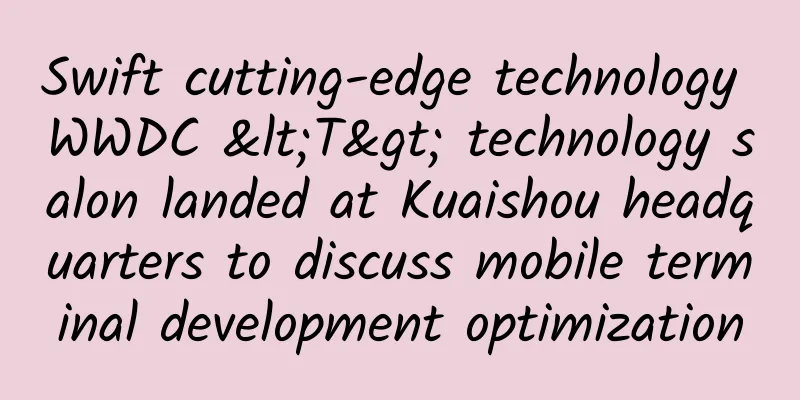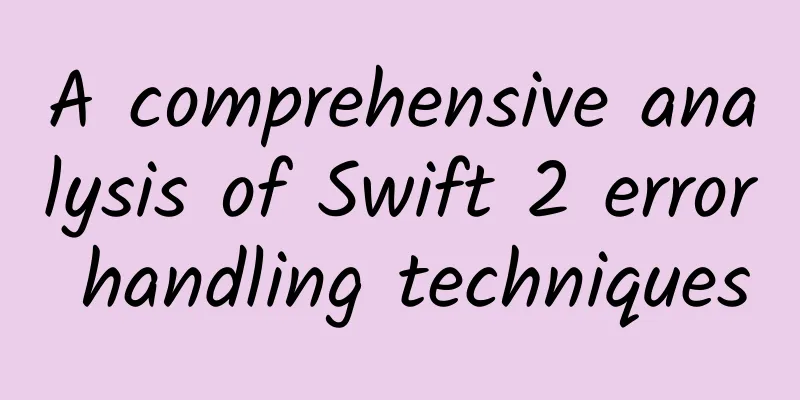Swift cutting-edge technology WWDC <T> technology salon landed at Kuaishou headquarters to discuss mobile terminal development optimization

|
Recently, mobile development engineers from Kuaishou, Meituan, Didi, ByteDance and other Internet companies gathered at the Kuaishou headquarters to participate in a WWDC <T> technical salon. iOS developers exchanged experiences with each other and sparked new ideas for the Swift community. Swift is a modern programming language open sourced by Apple. The process of writing Swift code is full of fun and interaction. Swift syntax is concise, but expressive, and includes modern features that developers love. Swift code is designed to be safe, and it can also develop software that runs as fast as lightning, which is sought after by a large number of developers. This event is the WWDC <T> Technology Salon, a special offline salon in Beijing, jointly organized by the "SwiftGG Translation Group" and "Kuaishou Middle School". <T> Technology Salon is an offline event IP of the SwiftGG Translation Group. The idea of the SwiftGG organizer is to communicate, not to give lectures. Because of the difference in levels, it will become a lecture. Only when the levels are similar can there be real communication. So, for offline activities, the meaning of offline activities is communication. This face-to-face communication cannot be replaced by any search engine or online tool, and the value generated by it is also unique. Swift has been unanimously recognized by developers after the ABI was stabilized and SwiftUI was launched. Coupled with the release of the popular Swift concurrency technology this year, Swift has shined. Swift makes Apple development more stable and efficient, and Kuaishou will also catch the Swift train. Currently, Kuaishou's AcFun and Kuaishou overseas versions have been developed on a large scale using Swift. This is to allow our users to use more stable and better performance products and have a better user experience. In addition to Swift-related topics, this exchange meeting also shared solutions for reducing package size and engineering build optimization to improve the development experience.
(▲Exchange scene) This exchange adopts a combination of offline and online participation. The exchange meeting opened some offline places for participants. All on-site audiences were required to wear masks, ensure that the temperature and health status were normal, and enter only after signing the health declaration. A certain distance was also maintained when entering the meeting and sitting. In addition, the entire exchange was live-broadcasted through the "Kuaishou APP", with a total number of viewers exceeding 15,000. Dai Ming, a mobile architect from the technical department of Kuaishou's main site, Song Xutao, a mobile technology expert from Meituan platform, Xu Jiguang, a senior engineer of Client Infrastructure from ByteDance, and Kong Hanning, a domestic mobile expert engineer from Didi, gave on-site presentations respectively. Paul Hudson, author of the Hacking With Swift series of books, and Chris Eidhof, co-founder of objc, greeted the developers on-site and online through video. Dai Ming used SwiftUI to write a PPT program to introduce SwiftUI. Unlike PowerPoint and Keynote, the program has rich animation effects, which are all achieved using SwiftUI's powerful GeometryEffect, GeometryReader, AnyTransition, AnimatablePair, Shape and other technologies. This session mainly shared some key technologies that can make the development experience closer to SwiftUI before the system supports SwiftUI. (▲Kuaishou-Dai Ming "Let's talk about SwiftUI" Song Xutao started by introducing the Machine Outliner and how it reduces the number of repeated instructions. He then introduced Uber's work, including how Uber achieves global outlink optimization and solutions for repeated outlinks. Finally, the global Outliner task was completed through LTO link-time optimization. (▲Meituan-Song Xutao "Using Global Machine Outliner to Reduce Duplicate Code") Xu Jiguang analyzed several major pain points that affect R&D efficiency based on the current mainstream componentization of iOS R&D model. He then introduced his thoughts on a good R&D experience, introduced the dynamic R&D model ARK, and explored the ARK R&D model in depth from two directions: core technology implementation and the implementation of the entire solution. (▲Byte-Xu Jiguang "Dynamic R&D Model-ARK") Kong Hanning started with the Pod binary pollution problem, and then introduced the advantages and disadvantages, principles and practices of Xcode Cache, including the cache working mechanism, how to use cache products to generate packages, etc. Finally, he discussed the implementation plan in multi-branch scenarios. (▲Didi-Kong Hanning "Using Xcode Cache to Speed Up Build Packaging") Then Paul Hudson shared "Build Software for iPhone 101" through a video. Paul expressed his expectations and confidence in the bright future of Swift. He also listed a lot of data to illustrate the current usage of Swift, including how many people are learning Swift, how many companies use Swift in production environments, and even mentioned how much money can be made by learning Swift. It really takes all aspects into consideration for students who plan to learn Swift. (▲ Paul Hudson (left) & Chris Eidhof (right)) Chris Eidhof shared "A Speed Run of Creating A TODO App in SwiftUI". Chris Eidhof used Live Coding to implement a TODO program step by step from scratch. Through a complete development process, he let everyone feel the simplicity and elegance of SwiftUI and learn a lot of Swift development skills. Kuaishou takes technology as its core competitiveness and attaches great importance to technological innovation and application. At the same time, it also hopes to share experiences with industry developers through more and more extensive technical exchanges, collide with more sparks of wisdom, and promote the continuous advancement of technology. As an internal professional talent training platform, "Kuaishou Middle School" aims to help talents grow and improve their professional capabilities and influence by providing rich and diverse professional classroom training, competitions, and technical exchanges. In the future, technical exchanges organized by Kuaishou Middle School will be held once a month. |
>>: Apple pushes the first public beta update of iOS/iPadOS 15
Recommend
The expiration date of a drug is not equal to its expiration date! Collect this "preservation secret"
How long can the medicines at home be preserved o...
What are the functions of the equipment rental mini program? How much does it cost to develop a machinery rental mini program?
With the continuous development of the economy, mo...
The technology that is sealed on the iPhone 6
In addition to allowing us to once again witness ...
Will the strongest gamma-ray burst reveal these supernova "explosive materials"?
"We are in awe and feel very lucky to be abl...
APP operation tips: How to retain users for a good APP!
You know APP development, but do you know APP oper...
A guide to writing popular short video scripts
With the gradual explosion of short videos this y...
3 tips for paid promotion of APP applications on Android channels
1. If you want to find real users, pay for the ap...
After petting a cat, a woman was admitted to the ICU due to respiratory failure! The culprit is shocking
Cat petting is one of life's great pleasures ...
The child has already committed self-harm, why do some parents still think that "he is pretending"?
A pair of parents came with their child to the ps...
Short video content operation methodology
Before I devoted myself to content operations, I ...
Tips for preventing malicious clicks in SEM promotion!
Those of us who do SEM promotion know that each k...
Zhihu traffic growth rules!
In the past November, Zhihu released its Q3 2021 ...
New research: Eating these foods regularly can reduce the risk of metabolic syndrome by 23%
Compiled by: Gong Zixin Have you ever thought abo...









